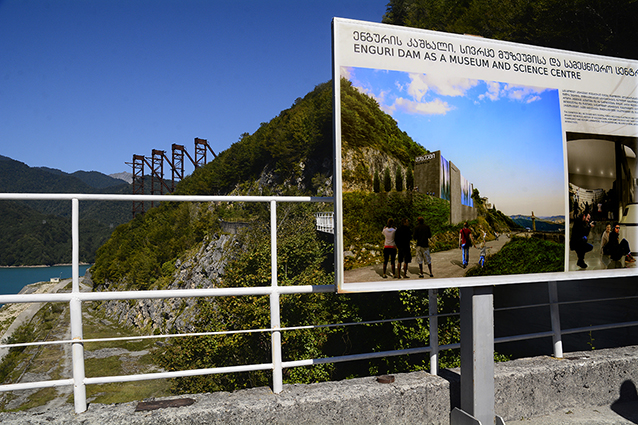Promoting tourism at Georgia’s unique Enguri dam

Georgia is encouraging people to go to the far north-west and visit one of the country’s most unique monuments, the Enguri River dam.
The dome-shaped dam is regarded as the world’s second largest concrete arch dam, measuring 271.5 metres high and 728 metres wide.
This week officials announced plans to build new tourist infrastructure at the site to encourage more local and foreign visitors. This new infrastructure included a visitor centre, museum and high lookout spots that overlooked Enguri River.
The dam located near Georgia’s north-western town of Jvari, was last year added to the list of the country’s most distinguished cultural heritage sights and officially granted the status of National Monument.

The arch-shaped dam is located on Enguri River, on the administrative boundary between Georgia and breakaway Abkhazia. Photo from Gela Bedianashvili/Ministry of Culture and Monument Protection of Georgia
Enguri dam is an interesting place in Georgia as it lies on the administrative boundary separating Georgia from its occupied Abkhazia region. The dam is part of the Enguri Hydro-Electric Power Plant.
In a unique division, the dam is located on Georgian-controlled territory while the underground station of the power plant - serving to generate electricity - is on the other side, under Abkhazian control. Because of this it is jointly operated by staff from both sides of the Administrative Boundary Line (ABL).
The plan to develop the monument was created with help from Estonian experts Ott Sarapuu and Andrus Koeresaar and will include efforts to involve the Abkhazian side in preparing a submission to recognise the dam as a UNESCO World Heritage Site.

A museum, tourist centre and lookout spots will soon be built overlooking Enguri River. Photo from Gela Bedianashvili/Ministry of Culture and Monument Protection of Georgia.
Recognised as the largest hydroelectric plant in South Caucasus, the Enguri power plant is a sprawling complex built on an area of nearly 1,000 km2, from Jvari town to the Black Sea.
The electricity generated by the dam goes back into grids in Abkhazia, while it also serves nearly half of Georgia's hydro energy requirements.
Construction of Enguri dam began in 1961 and at the time was unprecedented for its scale and ambition.

The Enguri dam reaches 271m high and 728m wide. Photo from Gela Bedianashvili/Ministry of Culture and Monument Protection of Georgia.
Completed in 1977, the dam was the final result of a half-century process initiated by Georgian public figure Niko Nikoladze (1843-1928) just before World War I. Aiming to find ways to use Georgia's rich hydroelectric potential, Nikoladze invited engineers from St. Petersburg, Russia to study the feasibility of building a plant on Enguri River.
Their efforts, as well as a number of follow-up projects over the following decades by independent experts and Soviet-era planners were deemed unfeasible due to financial and practical considerations, before the 1961 project received green light from authorities.
The final Enguri dam construction was the largest-ever industrial project in Georgia, with the finished plant attracting attention of international experts and global engineering publications over decades during the Soviet era.
Involving a specially created mix of concrete building material, the building was the largest arched hydroelectric dam in the world until a construction of a larger dam project in China began in 2012.
 Tweet
Tweet  Share
Share